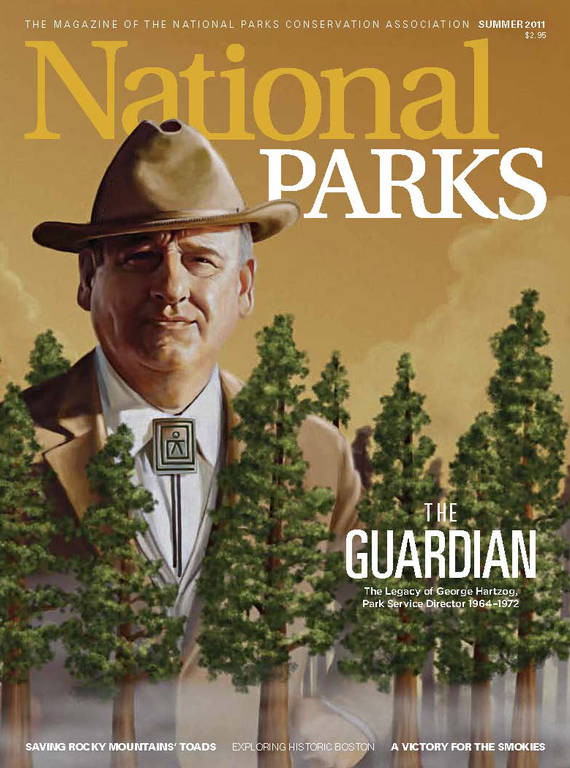Summer 2011
The Grouse Effect
An unlikely coalition is fighting to protect the Gunnison sage-grouse.
Theresa Childers, wildlife biologist at Black Canyon of the Gunnison National Park, is poring over a red-and-blue map revealing data that are key to a local political battle. But the map doesn’t chart election results: Red splotches indicate a high probability of Gunnison sage-grouse nesting; blue spots represent areas where nesting is unlikely. Childers is concerned that those red zones aren’t nearly as widespread as they used to be, and the only way to change that trend is to protect remaining habitat. It’s a battle that has brought together some unlikely collaborators.
Thankfully, the latest wave of wrangling has brought gains for the bird: Last fall, the Gunnison sage-grouse was designated a candidate for federal protection under the Endangered Species Act. Fewer than 5,000 birds remain in seven groups in Colorado and Utah, including some that number as few as 10 birds.
Habitat loss and fragmentation are largely responsible for their decline. Grouse prefer huge expanses of sage with a healthy understory of flowering plants and grasses to help them hide from predators. But throughout sagebrush country, overgrazing in the early 1900s thinned the understory, housing and agriculture have supplanted sage, and roads and trails bring human traffic that disturbs nesting. Even within national park boundaries, certain events can upset grouse: Colorado’s largest body of water, Blue Mesa Reservoir in Curecanti National Recreation Area, flooded an immense swath of sagebrush when the Bureau of Reclamation completed Blue Mesa Dam in 1966.
Like all grouse, Gunnison sage-grouse are generally shy, but when humans approach too closely, they explode out of the brush—a trait that’s earned them the nickname “heart-attack bird.” In spring, males overcome their shyness to perform elaborate predawn mating dances, puffing up their chests, fanning their tail feathers, and making unique popping sounds.
“They look like King Henry the Eighth, with their white breasts like the ermine collars of monarchs,” says Leigh Robertson, coordinator of the San Miguel Basin Gunnison Sage-Grouse Working Group. But once the sun rises and the courtship ends, the males go back to being Average Joes. “They go from bold and showy to totally invisible, camouflaged by the sage.”
Because Gunnison sage-grouse are extraordinarily faithful to their leks (the clearings where annual courtship dances take place), they’re reluctant to establish new sites when development destroys those mating grounds. Their site fidelity is so entrenched that grouse even danced on the ice of the Blue Mesa Reservoir for a few years after it was formed.
That’s why Childers and others are paying close attention to the bird’s remaining habitat. In southwest Colorado, the Park Service, Bureau of Land Management, area ranchers, county officials, and other local groups joined forces in 1995, more than a decade before the Gunnison sage-grouse became a candidate for the endangered species list. The grouse lost any potential federal protection in 2006 after the U.S. Fish and Wildlife Service determined it didn’t merit protection, but local efforts continued: Every spring sees more than 40 Gunnison-area road closures to reduce human impacts during mating season; a basin-wide seeding project has improved the understory across 100 miles of brood-rearing habitat; and building-permit applications are scrutinized for their potential impact on grouse and projects are adjusted to minimize disturbances.
“I’ve been in wildlife conservation for 40 years, and I’ve never seen this kind of effort on a single species in such a small area,” says Jim Cochran, Gunnison County wildlife conservation coordinator. “The possibility of [endangered species] listing has brought people on board that normally would not be on board. It galvanizes interest in the species, gets people’s attention, gets the community working.”

National Parks
You can read this and other stories about history, nature, culture, art, conservation, travel, science and more in National Parks magazine. Your tax-deductible membership donation of $25 or more entitles…
See more ›The Colorado Division of Wildlife (the agency currently responsible for the grouse) has spent more than $25 million to preserve and enhance grouse habitat. The Park Service, meanwhile, just concluded a 12-year research project that fitted radio collars on Gunnison sage-grouse and followed them throughout the year. Now, the U.S. Geological Survey is analyzing the data to understand nesting, summer, and winter habitat patterns.
Those findings will guide habitat protection efforts and will likely benefit all sagebrush animals—not just grouse. “It’s an indicator species that signals the overall health of the sagebrush ecosystem,” says Robertson. “If the ecosystem isn’t healthy, grouse are the first to show it.”
The grouse’s return to endangered species candidacy recognizes that role. It’s not clear whether it will attain threatened or endangered status, but some listing is likely, even if the process takes several years. As for the grouse’s prospects on Park Service lands, Childers is hopeful. With the local coalitions and potential listing, she says, this shy bird may finally be getting the help it needs to survive among the sage.



